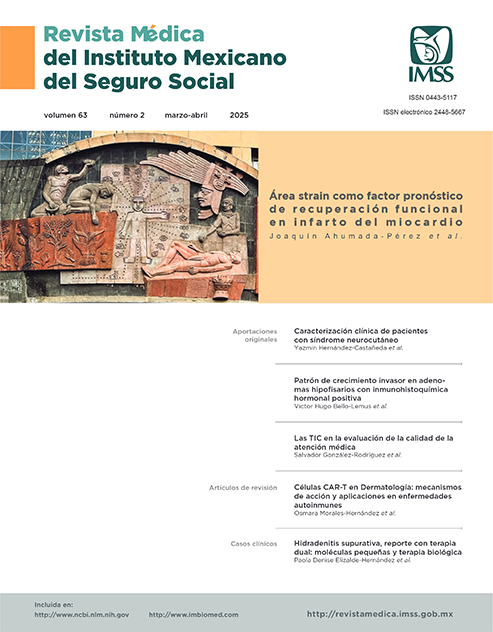Hidradenitis suppurativa, report with dual therapy: small molecules and biological therapy
Main Article Content
Keywords
Hidradenitis Suppurativa, Antibodies, Monoclonal, Humanized, Janus Kinase, Drug Therapy, Combination
Abstract
Abstract
Background: Hidradenitis suppurativa is an immune-mediated inflammatory disease that affects the pilosebaceous-apocrine unit, characterized by deep abscesses, painful nodules, and fistulas that connect them to each other or to the surface. This leads to infections that are difficult to control, abnormal healing, retractile tracts, and painful ulcers, complicating its management and affecting the patient’s wellbeing, favoring the development of depression and anxiety. Despite therapeutic advances, the available treatments offer inconsistent results, especially in advanced stages.
Clinical case: A 27-year-old female patient with five years of evolution of this condition in modified Hurley stage III is presented. Due to lack of response to conventional therapies, treatment with an anti-IL-17 biologic was started, with limited improvement. Due to the persistence of symptoms and functional impairment, a JAK inhibitor was added, achieving a favorable response within four weeks, with a reduction in pain as measured by the EVA scale, quality of life index (DLQI), and severity according to the modified Hurley scale.
Conclusion: Combined therapy mediated by cytokines and humoral response cells is proposed as an effective therapeutic strategy in patients with hidradenitis suppurativa in advanced stages, particularly in those with retractile and fistulous lesions (Hurley stages II and III), to improve clinical response in chronic or refractory cases.
References
Mansilla M, Escutia B, Botella B. Revisión narrativa y actualización en fármacos biológicos y de pequeña molécula para el tratamiento de la hidradenitis supurativa: una entidad con un futuro prometedor. Actas Dermo-Sifiliográficas. 2023;114(9): 772-783. doi: 10.1016/j.ad.2023.08.001.
Martora F, Megna M, Battista T, et al. Adalimumab, Ustekinumab, and Secukinumab in the Management of Hidradenitis Suppurativa: A Review of the Real-Life Experience. Clin Cosmet Investig Dermatol. 2023;19(16):135-148. doi: 10.2147/CCID.S391356.
Alavi A, Hamzavi I, Brown K, et al. Janus kinase 1 inhibitor INCB054707 for patients with moderate-to-severe hidradenitis suppurativa: results from two phase II studies. Br J Dermatol. 2022;186(5):803-813. doi: 10.1111/bjd.20969.
Olbrich P, Cortés J, Neth O, et al. STAT1 Gain-of-Function and Hidradenitis Suppurativa Successfully Managed with Baricitinib. J Clin Immunol. 2023;43(5):898-901. doi: 10.1007/ s10875-023-01454-2.
Glassner K, Oglat A, Duran A, et.al. The use of combination biological or small molecule therapy in inflammatory bowel disease: A retrospective cohort study. J Dig Dis. 2020;21(5):264- 271. doi: 10.1111/1751-2980.12867.
Armesto S, González-Vela C, Sánchez J, et al. Treating multidrug-resistant psoriasis with brodalumab, apremilast, methotrexate and prednisone combination therapy in the COVID-19 pandemic. Dermatologic Therapy. 2020;33:e14464. doi: 10.1111/dth.14464.
Chen J-W, Zhang W-S, Lin C-S, et.al. Case report: JAKi and TNFi dual therapy is a potential treatment strategy for difficult-to-treat rheumatoid arthritis. Front. Immunol. 2022;13:1074329. doi: 10.3389/fimmu.2022.1074329.
Hasan MJ, Rabbani R, Anam AM, et al. Secukinumab in severe COVID-19 pneumonia: Does it have a clinical impact? J Infect. 2021;83(1):e11-e13. doi: 10.1016/j.jinf.2021.05.011.
Sabat R, Jemec GBE, Matusiak Ł, et al. Hidradenitis suppurativa. Nat Rev Dis Primers. 2020;6(1):18. doi: 10.1038/ s41572-020-0149-1.
Garcovich S, Genovese G, Moltrasio C, et al. PASH, PAPASH, PsAPASH, and PASS: The autoinflammatory syndromes of hidradenitis suppurativa. Clin Dermatol. 2021;39(2):240-247. doi: 10.1016/j.clindermatol.2020.10.016.
Goldburg S, Strober B, Payette M. Hidradenitis suppurativa: Epidemiology, clinical presentation, and pathogenesis. J Am Acad Dermatol. 2020;82(5):1045-1058. doi: 10.1016/j.jaad. 2019.08.090.
Toni J, Jahdonna I, Edwards A, et al. Hidradenitis Suppurativa. Dermatologic Clinics. 2023;41(3). doi:10.1016/j.det. 2023.02.001.
Kimball AB, Okun MM, Williams DA, et al. Two Phase 3 Trials of Adalimumab for Hidradenitis Suppurativa. N Engl J Med. 2016; 375(5):422-34. doi: 10.1056/NEJMoa1504370.
Islam Z, Ch’en P, Choi S, et al. The utility of upadacitinib to treat refractory hidradenitis suppurativa in an obese patient. JAAD Case Repo. 2024. doi: 10.1016/j.jdcr.2024.08.002.
Savage K, Santillan M, Flood K, et al. Tofacitinib shows benefit in conjunction with other therapies in recalcitrant hidradenitis suppurativa patients. JAAD Case Rep. 2020;6(2):99-102. doi: 10.1016/j.jdcr.2019.10.010.
Kirby J, Okun M, Alavi A, et al. Efficacy and safety of the oral Janus kinase 1 inhibitor povorcitinib (INCB054707) in patients with hidradenitis suppurativa in a phase 2, randomized, double-blind, dose-ranging, placebo-controlled study. J Am Acad Dermatol. 2024;90(3):521-529. doi: 10.1016/j.jaad.2023.10.034.
Yu Y, Ding X, Guo F, et al. Perifolliculitis capitis abscedens et suffodiens treatment with tumor necrosis factor inhibitors and baricitinib: A case report and literature review. Front Med (Lausanne). 2023;28(10):1132574. doi: 10.3389/fmed.2023.1132574.
Kelly G, Sweeney CM, Tobin AM, et al. Hidradenitis suppurativa: the role of immune dysregulation. Int J Dermatol. 2014; 53(10):1186-96. doi: 10.1111/ijd.12550.
Xu H, Xiao X, He Y, et al. Increased serum interleukin-6 levels in patients with hidradenitis suppurativa. Adv Dermatol Allergol. 2017;34(1):82-84. doi: 10.5114/ada.2017.65626.
Jepsen R, Edwards C, Flora A, et al. A proof-of-concept open-label clinical trial of spleen tyrosine kinase antagonism using fostamatinib in moderate-to-severe hidradenitis suppurativa. J Am Acad Dermatol. 2023;89(4):694-702. doi: 10.1016/j.jaad.2023.05.076.
Huang I, Chung W, Wu P, et al. JAK-STAT signaling pathway in the pathogenesis of atopic dermatitis: An updated review. Front Immunol. 2022;8(13):1068260. doi: 10.3389/fimmu.2022. 1068260.
Freitas E, Guttman E, Torres T. Baricitinib for the Treatment of Alopecia Areata. Drugs. 2023;83:761-770. doi: 10.1007/ s40265-023-01873-w.
Takahashi T, Yamasaki K, Terui H, et al. Perifolliculitis capitis abscedens et suffodiens treatment with tumor necrosis factor inhibitors: A case report and review of published cases. J Dermatol. 2019;46(9):802-807. doi: 10.1111/1346-8138.14998.
Navrazhina K, Renert Y, Khattri S, et al. Tape strips detect molecular alterations and cutaneous biomarkers in skin of patients with hidradenitis suppurativa. J Am Acad Dermatol. 2024;90(4):749-758. doi: 10.1016/j.jaad.2023.11.048.
Marzano A, Genovese G, Casazza G, et al. Evidence for a ‘window of opportunity’ in hidradenitis suppurativa treated with adalimumab: a retrospective, real-life multicentre cohort study. Br J Dermatol. 2021;184(1):133-140. doi: 10.1111/bjd.18983.


